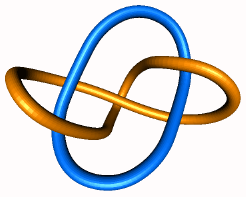J. H. C. Whitehead facts for kids
Quick facts for kids
J. H. C. Whitehead
|
|
|---|---|
 |
|
| Born | 11 November 1904 |
| Died | 8 May 1960 (aged 55) |
| Nationality | British |
| Alma mater | Oxford University Princeton University |
| Known for | Collapse CW complex Crossed module Simple homotopy Whitehead conjecture Whitehead group Whitehead link Whitehead manifold Whitehead problem Whitehead product Whitehead theorem Whitehead torsion Whitehead tower Whitehead's algorithm Whitehead's lemma Whitehead's point-free geometry Spanier–Whitehead duality |
| Awards | Senior Berwick Prize (1948) Fellow of the Royal Society |
| Scientific career | |
| Fields | Mathematics |
| Institutions | Oxford University |
| Doctoral advisor | Oswald Veblen |
| Doctoral students |
|
John Henry Constantine Whitehead (born November 11, 1904 – died May 8, 1960) was a British mathematician. People often called him Henry. He was one of the main people who helped create a field of math called homotopy theory. Henry was born in Chennai, India, and passed away in Princeton, New Jersey, in 1960.
Contents
About Henry Whitehead
Henry Whitehead's father was a bishop in India who had also studied math. His uncle was Alfred North Whitehead, a famous philosopher and mathematician. Henry grew up in Oxford, England. He went to Eton College and then studied math at Balliol College, Oxford University.
Early Career and Studies
After college, Henry worked for a year as a stockbroker. This means he helped people buy and sell stocks. But he soon decided to go back to school. In 1929, he started working on his PhD at Princeton University in the United States. He finished his PhD in 1930. While at Princeton, he also worked with another important mathematician, Solomon Lefschetz.
In 1933, Henry became a fellow at Balliol College, Oxford. This meant he was a senior member of the college. In 1934, he married Barbara Smyth, who was a talented concert pianist. They had two sons together. In 1936, he helped start a math club for students at Oxford called The Invariant Society.
Work During World War II
During World War II, Henry used his math skills to help his country. He worked on "operations research," which is about using math to solve real-world problems. He helped with strategies for submarine warfare.
Later, he joined the secret codebreakers at Bletchley Park. This was a top-secret place where British experts worked to break enemy codes. By 1945, Henry was part of a team called the "Newmanry." This team used early digital electronic computers, like the Colossus computer, to break German secret messages.
Later Life and Legacy
From 1947 to 1960, Henry was a very important math professor at Magdalen College, Oxford. He was known as the Waynflete Professor of Pure Mathematics.
He also led the London Mathematical Society (LMS) from 1953 to 1955. This is a group for mathematicians in London. After he passed away, the LMS created two special awards in his memory. These are the Whitehead Prize and the Senior Whitehead Prize.
Henry Whitehead died suddenly from a heart attack in May 1960 while visiting Princeton University. In the late 1950s, he had planned to start a new math journal called Topology. Sadly, he died before the first issue came out in 1962.
Henry's Math Work
Henry Whitehead made big contributions to a field of math called topology. Topology is like studying the shapes of objects and how they connect, even if you stretch or bend them.
He helped create a way to understand complex shapes using something called "CW complexes." This made it easier for mathematicians to study these shapes. He also came up with the idea of simple homotopy theory, which explores how shapes can be changed into each other.
Henry also worked on something called the Whitehead product, which is an operation used in homotopy theory. He also helped define "crossed modules," another important idea in math. His work on topology even led to the idea of the Whitehead manifold, which is a special kind of mathematical space. He also studied how shapes can be broken down into simpler pieces, like triangles.


